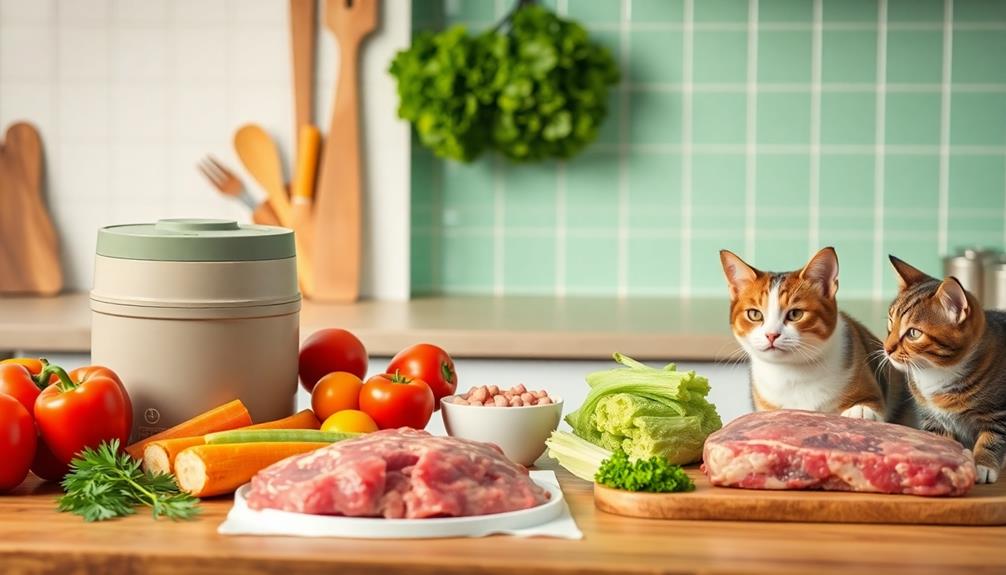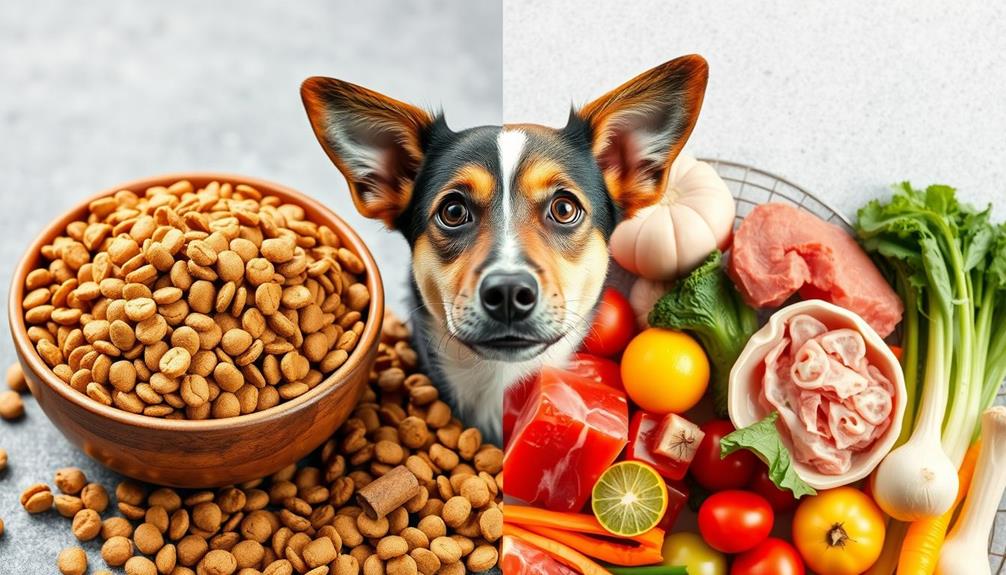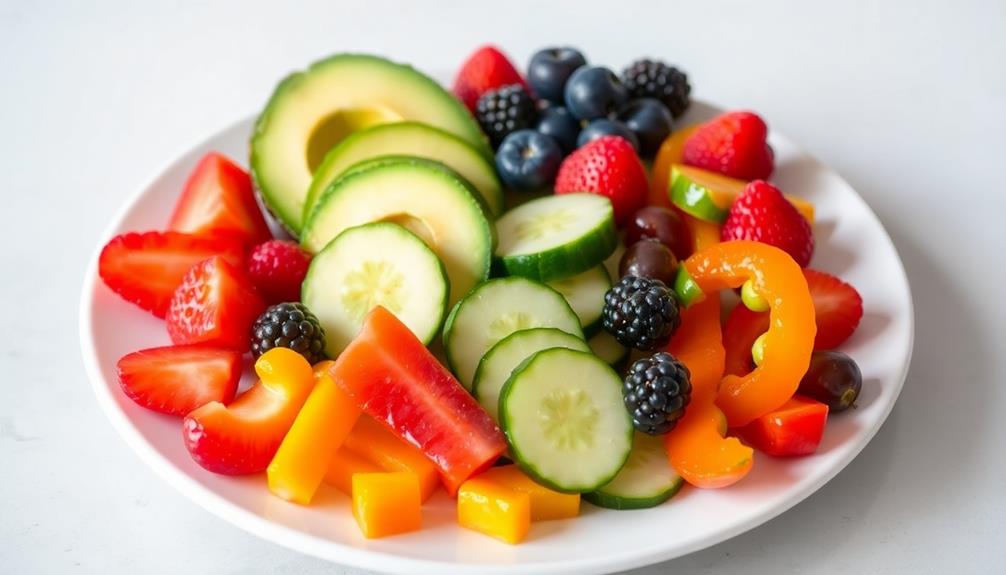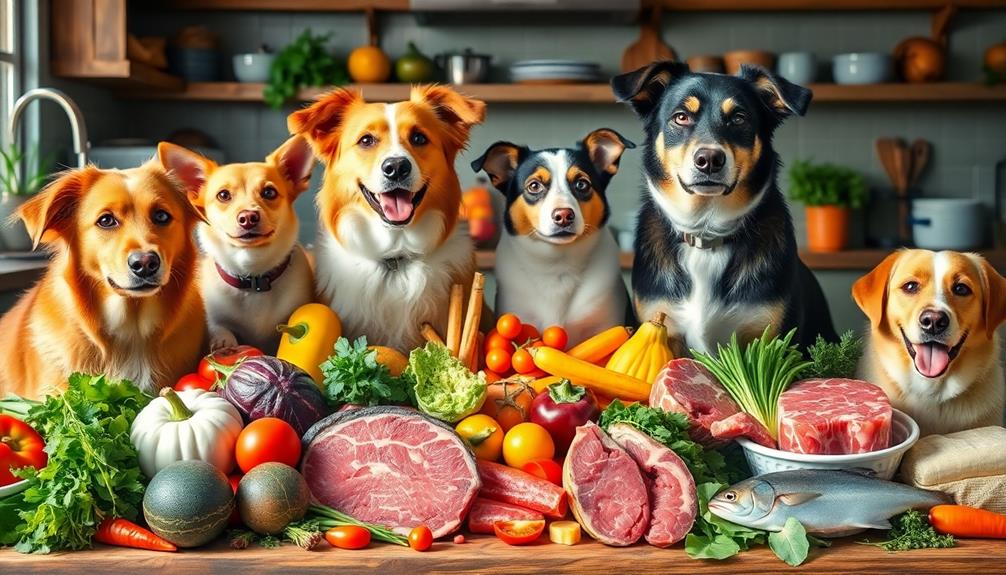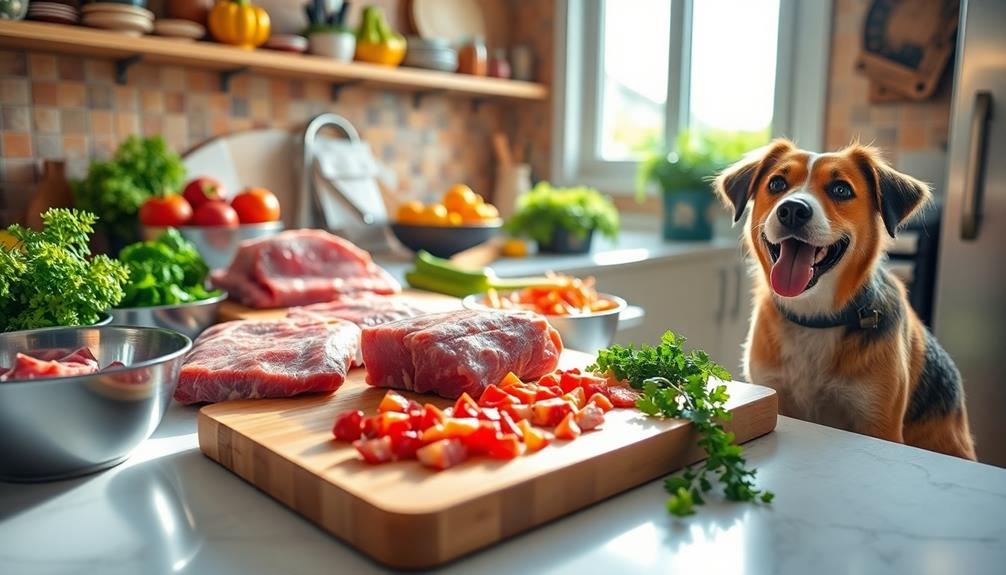Storing raw dog food safely is vital for keeping it fresh and nutritious. Use airtight containers made of BPA-free plastic or glass to prevent spoilage and contamination. It's best to freeze your pet's food into pre-portioned servings, which makes thawing a breeze. Always thaw in the refrigerator overnight and never leave it out for too long. Remember to wash your hands and surfaces after handling raw food to maintain hygiene. By following these tips, you can guarantee your pet enjoys a healthy diet. You might find even more helpful strategies as you explore further.
Key Takeaways
- Store raw dog food in airtight, freezer-rated containers to maintain freshness and prevent contamination.
- Divide food into pre-measured portions for easy thawing and feeding convenience.
- Thaw raw food in the refrigerator overnight or in warm water for quick access.
- Always label containers with meat type and storage date to track freshness effectively.
- Implement good hygiene practices, such as washing hands and utensils after handling raw food.
Importance of Raw Food Storage
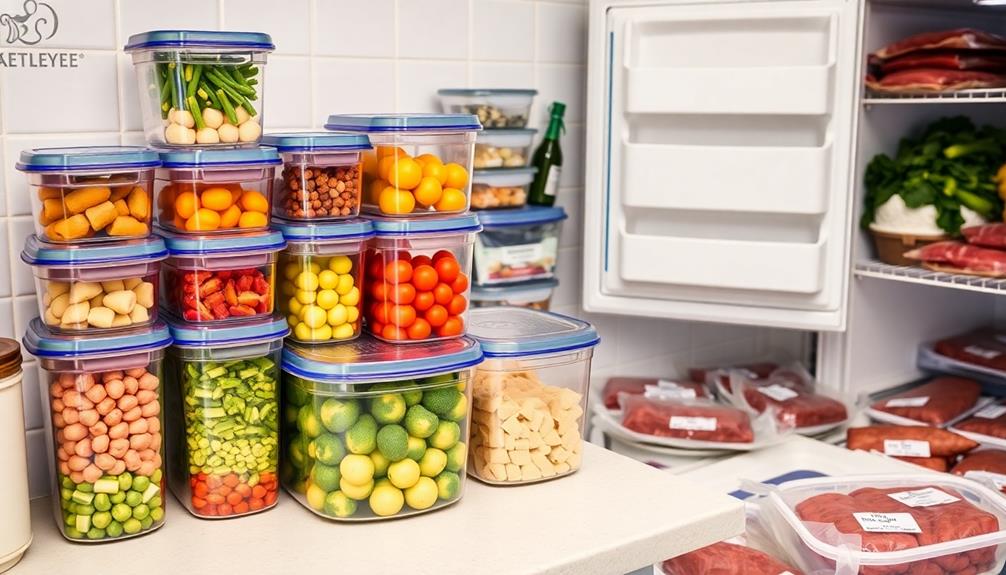
When you choose to feed your pet raw food, proper storage becomes vital for their health. Raw dog food can spoil quickly, especially once it's thawed. In fact, refrigerated raw food only lasts for 2-3 days after thawing.
To maintain freshness and nutritional value, freezing is the safest method for long-term storage. This way, you can guarantee your furry friend gets the best quality food without the risk of spoilage.
When it's time to thaw, do so in the refrigerator overnight. Remember, once it's thawed, you've got a 48-hour window to use it safely.
Using airtight containers for your raw dog food is imperative as it helps prevent contamination from odors and pests. These food storage containers create a barrier that keeps your pet's meals fresh and safe.
Don't forget to practice good hygiene after handling raw food. Washing your hands and utensils minimizes health risks for both you and your pet.
Best Containers for Raw Food

When it comes to storing raw food for your pets, choosing the right containers is essential.
You'll want airtight options that can withstand freezing temperatures while allowing for easy portion control and safe thawing methods.
This not only keeps your pet's food fresh but also makes mealtime more convenient for you.
Airtight Freezer Storage Options
Airtight freezer storage options are essential for keeping your pet's raw food fresh and safe. These containers prevent air and moisture from degrading the food quality, extending its shelf life. When choosing storage solutions, opt for freezer-rated containers made from BPA-free plastic or glass. They resist brittleness, maintaining durability in low temperatures.
Vacuum-sealed bags are another effective choice. They remove excess air, greatly reducing the risk of freezer burn. If you want to enhance preservation further, consider using oxygen absorbers within your airtight containers. This minimizes oxygen exposure, preventing spoilage and maintaining flavor.
To optimize freezer space and keep your pet's food organized, stackable containers are a great option. They allow for efficient meal planning, making it easier for you to access what you need quickly.
| Container Type | Benefits |
|---|---|
| BPA-free Plastic | Durable, safe for food storage |
| Glass Containers | Non-toxic, maintains freshness |
| Vacuum-Sealed Bags | Reduces freezer burn, maximizes space |
Portion Control Techniques
Managing your pet's raw food storage goes beyond just using the right containers; it also involves effective portion control techniques. Start by selecting sturdy, BPA-free plastic containers designed for freezer use. These containers help guarantee your pet's food stays safe and free from harmful chemicals.
Consider portion sizes carefully—dividing raw food into individual servings, like 250g patties, makes thawing and feeding a breeze. This approach not only reduces waste but also allows for quick access when your pet's mealtime rolls around.
Opt for stackable freezer containers to maximize space in your freezer while keeping everything organized.
Don't forget the importance of airtight sealing. Make sure all containers are tightly sealed to prevent freezer burn, which can compromise the quality and nutritional value of the food.
Label each container with the type of meat and the date of storage to track freshness easily. This way, you can guarantee your pet enjoys a variety of flavors without any confusion.
Safe Thawing Methods
Thawing raw pet food safely is vital for maintaining its quality and nutritional value. The best practice is to place the food in the refrigerator overnight. This gradual thawing method guarantees that the raw pet food stays at a safe temperature, preventing harmful bacteria growth.
If you need a quicker option, immersing sealed raw food in warm water for 15-30 minutes can expedite the thawing process.
After thawing, make certain to consume the raw dog food within 48 hours to keep it fresh and safe. It's essential to avoid cooking the food, as it can destroy the beneficial nutrients and enzymes that your pet needs.
For ideal storage and thawing, use airtight, freezer-rated containers. These freezer containers not only prevent freezer burn but also help maintain the nutritional integrity of the raw pet food.
Freezing Raw Dog Food
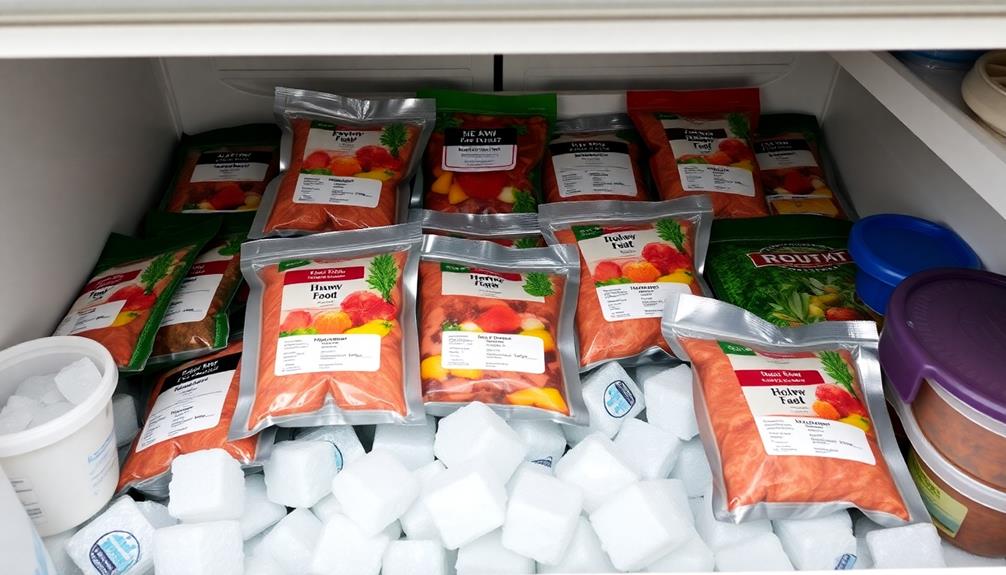
Freezing your dog's raw food is key to keeping it fresh and nutritious, so you'll want to master ideal freezer techniques.
Organizing those frozen portions makes it easier to grab what you need without digging around, while knowing the best thawing methods guarantees your pup gets a safe and tasty meal.
Let's explore how to make the most of your freezer space and simplify your meal prep.
Optimal Freezer Techniques
When it comes to storing raw dog food, using the freezer is vital for keeping it fresh and safe. Many brands offer convenient portions, like Big Dog Raw Foods' 250g packages, which help streamline your pet food storage.
To make the most of your freezer space, unpack and stack patties, verifying they're in airtight packaging. This step is important since it prevents freezer burn, which can compromise the quality of your raw food.
If you have multiple pets or buy in bulk, consider investing in a second or chest freezer. This extra space can be a lifesaver for keeping your pet's diet consistent.
When it's time to thaw the raw food, aim to do it overnight in the refrigerator. If you're short on time, a warm water bath for 15-30 minutes works well, too.
Always remember that once raw food is thawed, it should be consumed within 48 hours to maintain safety and quality, since it contains no preservatives.
Following these best freezer techniques will guarantee your dog's meals remain nutritious and delicious.
Organizing Frozen Portions
Organizing your frozen raw dog food portions can make mealtime smoother and more efficient. Start by storing your raw diet in 250g sealed packages, which helps maintain freshness and manage serving sizes.
Using containers that fit well in your freezer can help you maximize space while making it easier to access the food you need.
Consider stacking unpacked patties vertically in the freezer for efficient use of space. This not only keeps everything organized but also allows you to grab what you need quickly.
If you have multiple pets or larger storage requirements, investing in a second or chest freezer can help you keep different flavors separate and easily identifiable.
Label each container with the flavor and the date of freezing. This way, you can track freshness and your pets' preferences.
Remember, thawed raw dog food should be consumed within 48 hours to guarantee safety and prevent spoilage.
Thawing Methods Explained
After you've organized your frozen raw dog food portions, the next step is thawing them safely to confirm your pet enjoys the meal at its best quality. The best way to thaw raw meat is in the refrigerator overnight. This method guarantees a gradual temperature change, maintaining the integrity of the stored food while keeping it safe from bacterial growth.
If you forget to plan ahead, you can use a warm water bath to thaw the food quickly. Just place the sealed raw meat in warm water, and it should be ready in about 15-30 minutes. Just be careful not to let it exceed the recommended temperature for safety.
Once thawed, it's essential to serve the raw dog food within 48 hours to prevent any spoilage. Remember, never cook raw food, as it contains important ingredients like offal and bones that are crucial for your pet's health.
For portion control, use a spoon to serve the defrosted food, allowing for accurate measurement and minimizing waste. With these thawing methods, you'll keep your dog's meals fresh and nutritious!
Handling Raw Dog Food Safely

Handling raw dog food safely is crucial for your pet's health. If you're a pet owner, you must be aware of the risks associated with bacterial growth. Follow these tips to keep your furry friend safe:
- Separate Utensils: Always use different utensils for serving raw foods. This prevents cross-contamination with other foods, reducing the risk of harmful bacteria spreading.
- Wash Your Hands: After handling raw dog food, wash your hands thoroughly. This simple step helps maintain hygiene and stops bacteria from spreading to surfaces or other meals.
- Timely Consumption: Once you've thawed raw dog food, guarantee it's consumed within 48 hours. This limits the opportunity for bacterial growth, keeping your pet safe and healthy.
Thawing Techniques for Raw Food
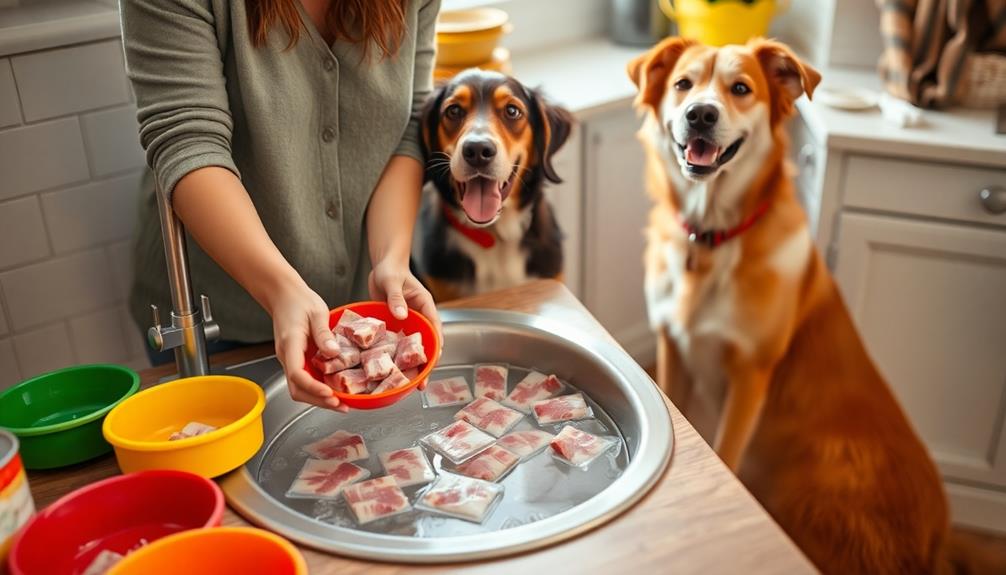
When it comes to thawing raw food for your pet, using the refrigerator overnight is the safest method to maintain quality.
If you're in a pinch, a warm water bath can quickly get the job done in about 15-30 minutes.
Best Thawing Methods
To guarantee your pet's raw food thaws safely and retains its nutritional benefits, the best method is to place it in the refrigerator overnight. This gradual thawing process helps preserve the food's quality and guarantees your furry friend gets all the nutrients they need.
However, if you need a quicker solution, consider these alternative thawing raw dog food methods:
- Warm Water Bath: Submerge smaller portions of raw food in a sealed bag in warm water for 15-30 minutes. This method is effective but requires your attention to avoid overheating.
- Countertop Thawing: If you're short on time, you can leave the food on the countertop for a few hours. Just be cautious about the room temperature, as it can affect food safety.
- Avoid Cooking: Always remember, never cook raw dog food. Cooking can destroy the beneficial nutrients and enzymes that are crucial for your pet's health.
Once thawed, be sure to serve the food within 48 hours to prevent spoilage.
Always use a dedicated utensil to scoop out the food remains and minimize cross-contamination.
Storage After Thawing
After thawing your pet's raw food, proper storage is key to keeping it fresh and safe for your furry companion. Ideally, you should thaw raw dog food in the refrigerator overnight to maintain its quality. If you can't refrigerate, a warm water bath is a good alternative, allowing you to thaw the food in just 15-30 minutes.
Once thawed, remember that raw food should be consumed within 48 hours. This timeframe helps prevent bacterial growth, ensuring your pet stays healthy. If your pet doesn't eat all the food within that period, consider portioning it out using a spoon to minimize waste.
It's important to avoid cooking raw food, as heat can destroy the essential nutrients found in raw offal and bones, which are beneficial for your pet's health.
By carefully managing storage and consumption, you can provide your pet with the nutrients they need while keeping their food safe. Always check for signs of spoilage before serving, and when in doubt, throw it out.
Proper storage after thawing is an essential part of keeping your pet's raw diet safe and nutritious.
Shelf Life of Raw Dog Food
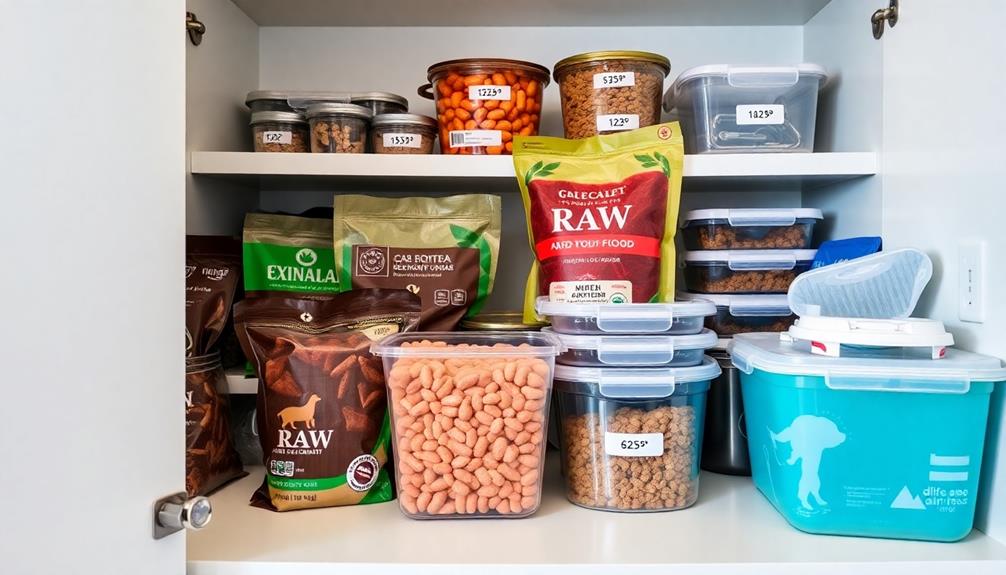
The shelf life of raw dog food is particularly shorter than that of processed options, primarily due to its natural ingredients. This means you need to be vigilant about its freshness.
Typically, after thawing, raw dog food should be consumed within 2-3 days. To help you manage this, here are some tips:
- Storage: Always store leftover raw dog food in a tightly sealed container. This reduces exposure to air and bacteria.
- Labeling: If you have multiple flavors for different pets, label each container with the date and flavor. This helps you keep track of what needs to be consumed first.
- Monitoring: Discard any raw food not consumed within the recommended timeframe. It's better to be safe than sorry when it comes to your pet's health.
Hygiene Practices for Raw Food
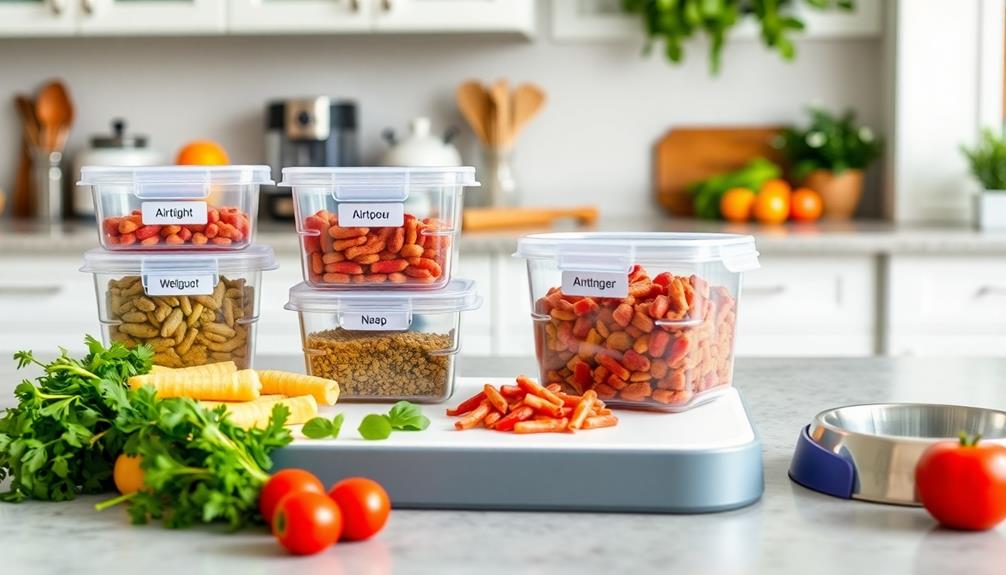
Maintaining hygiene practices when handling raw dog food is essential for both your pet's health and your own. Start by washing your hands thoroughly with soap and water immediately after handling raw dog food. This simple step helps prevent cross-contamination and reduces the risk of bacterial infection.
Next, clean your pet's dishes with hot, soapy water after each feeding. This eliminates any residual raw food and avoids potential contamination.
It's also vital to use separate utensils and cutting boards for preparing raw food, as this minimizes the risk of cross-contamination with your own food.
When it comes to storage, always keep raw dog food in airtight containers in the freezer to maintain its freshness and prevent harmful bacteria from growing.
Thaw raw food in the refrigerator or a warm water bath, avoiding room temperature to further prevent bacterial growth.
Portion Control Strategies
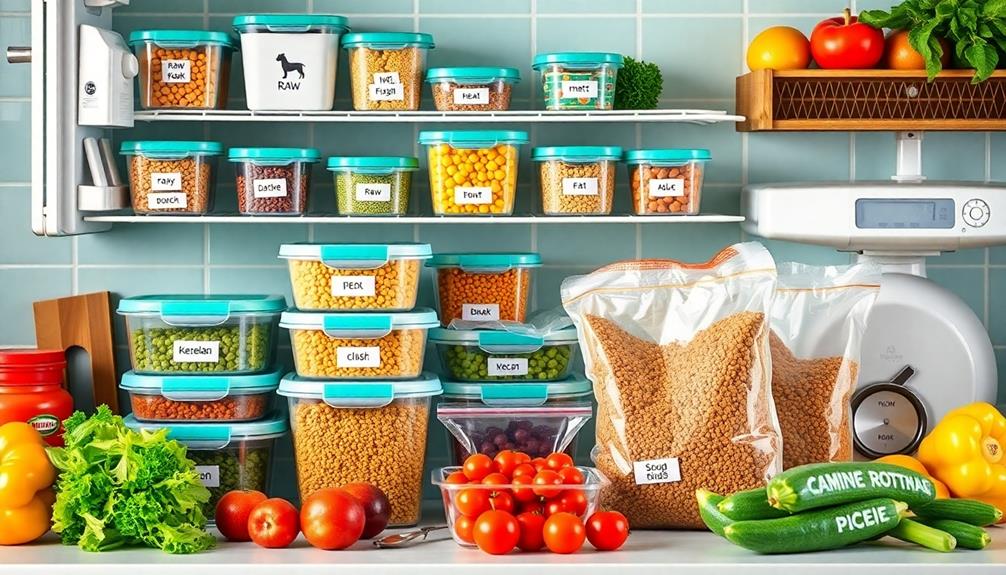
Proper hygiene practices set the stage for effective portion control in your pet's raw food diet. To maintain a healthy weight and guarantee your furry friend gets the right nutritional value, it's essential to implement some strategies.
Here are three effective tips to help you with portion control:
- Use Pre-Measured Portion Bags: By dividing daily intake into pre-measured portion bags, you not only streamline feeding times but also secure consistent serving sizes. This makes it easier for you to manage your pet's diet.
- Weigh Portions with a Kitchen Scale: Precise measurements are significant, especially based on your dog's weight and activity level. A kitchen scale can help you accurately weigh portions, preventing overfeeding.
- Label for Multiple Pets: If you have more than one pet, label containers or bags with each dog's name and portion size. This prevents mix-ups and guarantees that each pet receives the correct amount of food.
Additionally, consider implementing a meal prep schedule to thaw and portion raw food ahead of time. This enhances convenience and promotes food safety by minimizing the time raw food is left out.
Signs of Spoilage in Raw Food
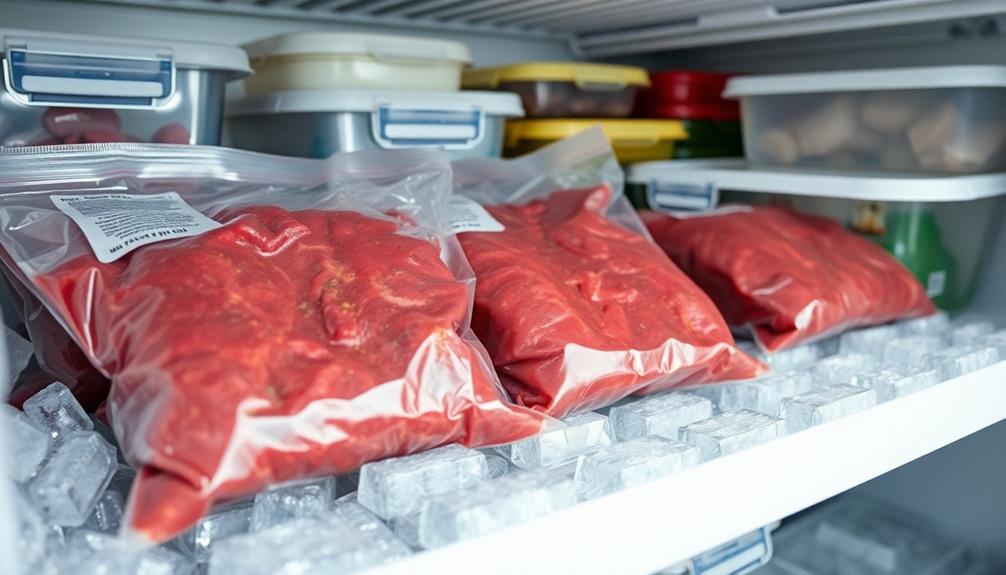
Spoilage in raw pet food can pose serious health risks, so it's crucial to recognize the signs early. As a dog owner, you should be vigilant when it comes to the freshness of the raw food you provide.
An off or sour smell is one of the first indicators that spoilage has occurred. This unpleasant odor suggests bacterial growth and degradation of the meat quality, making it unsafe for your pet.
Additionally, watch for changes in color. If you notice a grey or green tint, it's time to dispose of the food immediately.
A slimy or sticky texture on the surface is another red flag that indicates spoilage. If you encounter visible signs of mold or any unusual discoloration, discard the raw food without hesitation, as it poses a significant health risk to your furry friend.
Nutritional Benefits of Raw Diets

Embracing a raw diet for your pet can lead to remarkable improvements in their overall health and well-being. Raw diets are packed with essential nutrients, offering higher levels of protein, vitamins, and minerals compared to processed kibble. This can enhance your pet's liveliness and longevity.
Here are some key nutritional benefits of raw diets:
- Improved Digestion: The natural enzymes in fresh and nutritious raw foods promote better digestion and nutrient absorption, helping to alleviate digestive issues.
- Healthier Skin and Coat: The natural fats in raw meats contribute to ideal skin hydration, leading to a shinier coat and healthier skin overall.
- Increased Energy Levels: Many pet owners notice a boost in their pets' energy and improved behavior after changing to a raw diet, likely due to the absence of fillers and artificial additives found in commercial foods.
Incorporating different types of meats and organs in a raw diet guarantees a balanced intake of nutrients tailored to your pet's needs.
Frequently Asked Questions
How Do You Store Raw Pet Food?
To store raw pet food, freeze it to keep it fresh. Use sealed portions for easy access, and label them by flavor. Always thaw in the fridge overnight and use within 48 hours for safety.
What Is the Best Storage for Raw Dog Food?
Think of your dog's food as a treasure; store it in the freezer to keep it fresh. Use sealed portions for convenience, and don't forget to label them for easy access and dietary tracking!
How Long Can You Leave Raw Food Out for Pets?
You shouldn't leave raw food out for more than 2 hours at room temperature. In temperatures above 90°F, reduce that to just 1 hour. Always discard uneaten food after this time to guarantee safety.
What Is the Best Cooler for Raw Dog Food?
"You get what you pay for." When choosing a cooler, prioritize brands like YETI or Coleman. Look for durable insulation, adequate capacity, and portability features to keep your food fresh and easy to transport.
Conclusion
To summarize, storing raw food for your pets isn't just a chore—it's a game-changer for their health and happiness! By choosing the right containers, practicing safe handling, and mastering thawing techniques, you can guarantee your furry friends get the best nutrition possible. With a little attention to hygiene and portion control, you'll be a raw food storage wizard! Remember, a well-fed pet is a happy pet, and that's worth its weight in gold!

